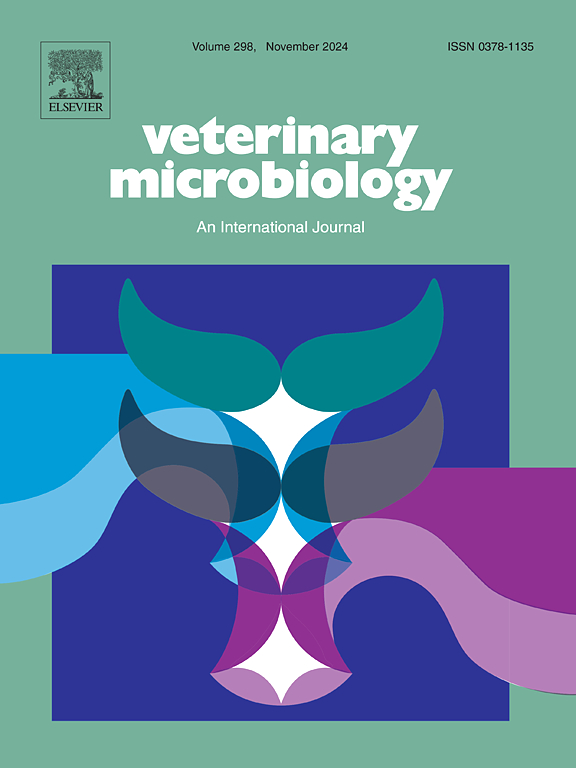Refining genetic classification of global porcine reproductive and respiratory syndrome virus type 1 (PRRSV-1) and investigating their geographic and temporal distributions
IF 2.4
2区 农林科学
Q3 MICROBIOLOGY
引用次数: 0
Abstract
Porcine reproductive and respiratory syndrome virus type 1 (PRRSV-1) primarily circulates in Europe but is also detected in North America and Asia. Based on ORF5 sequences, previous studies classified PRRSV-1 into four subtypes. Subtype 1 was further classified into 12 clades (A-L) or into three lineages with lineage 1 including clades 1A-1G and lineage 3 including clades 3A–3G, but the systems are inconsistent and have not been adopted. In this study, we proposed a statistically supported PRRSV-1 genetic classification system based on 10,446 global PRRSV-1 ORF5 sequences spanning 1991–2023. We replaced the colloquial “subtype” designation with “lineage” to reflect evolutionary history and, subsequently, PRRSV-1 was classified into four lineages (L1-L4) with L1 including 18 sublineages (L1.1 to L1.18). The proposed classification system is flexible and may be amended if additional lineages, sublineages, or more granular classifications are needed to reflect contemporary PRRSV-1 detections and evolution. Geographic distributions of PRRSV-1 at lineage and sublineage levels were distinct, with L1 globally distributed and L2, L3 and L4 more restricted. Temporal dynamic changes in some countries were quantified. Classification and ORF5 nucleotide identity of six commercial PRRSV-1 vaccines to each lineage and sublineage and detection frequency of vaccine-like viruses were determined. The phylogenies based on whole-genome and ORF5 sequences demonstrated slightly different tree topologies. Recombination of PRRSV-1 was observed at within-sublineage and between-sublineage levels. A set of ORF5 reference sequences representing the refined classification is available for future diagnostic and epidemiological applications. This study provides a benchmark delineating the current genetic diversity of PRRSV-1 and introduces a refined classification system to support the global standardization and application of ORF5-based genetic classification for PRRSV-1.
求助全文
约1分钟内获得全文
求助全文
来源期刊

Veterinary microbiology
农林科学-兽医学
CiteScore
5.90
自引率
6.10%
发文量
221
审稿时长
52 days
期刊介绍:
Veterinary Microbiology is concerned with microbial (bacterial, fungal, viral) diseases of domesticated vertebrate animals (livestock, companion animals, fur-bearing animals, game, poultry, fish) that supply food, other useful products or companionship. In addition, Microbial diseases of wild animals living in captivity, or as members of the feral fauna will also be considered if the infections are of interest because of their interrelation with humans (zoonoses) and/or domestic animals. Studies of antimicrobial resistance are also included, provided that the results represent a substantial advance in knowledge. Authors are strongly encouraged to read - prior to submission - the Editorials (''Scope or cope'' and ''Scope or cope II'') published previously in the journal. The Editors reserve the right to suggest submission to another journal for those papers which they feel would be more appropriate for consideration by that journal.
Original research papers of high quality and novelty on aspects of control, host response, molecular biology, pathogenesis, prevention, and treatment of microbial diseases of animals are published. Papers dealing primarily with immunology, epidemiology, molecular biology and antiviral or microbial agents will only be considered if they demonstrate a clear impact on a disease. Papers focusing solely on diagnostic techniques (such as another PCR protocol or ELISA) will not be published - focus should be on a microorganism and not on a particular technique. Papers only reporting microbial sequences, transcriptomics data, or proteomics data will not be considered unless the results represent a substantial advance in knowledge.
Drug trial papers will be considered if they have general application or significance. Papers on the identification of microorganisms will also be considered, but detailed taxonomic studies do not fall within the scope of the journal. Case reports will not be published, unless they have general application or contain novel aspects. Papers of geographically limited interest, which repeat what had been established elsewhere will not be considered. The readership of the journal is global.
 求助内容:
求助内容: 应助结果提醒方式:
应助结果提醒方式:


